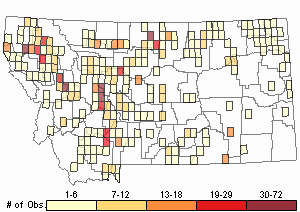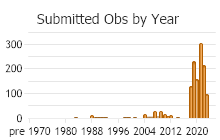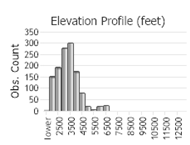View in other NatureServe Network Field Guides
NatureServe
Montana
Utah
Wyoming
Idaho
Wisconsin
British Columbia
South Carolina
Yukon
California
New York
Virile Crayfish - Faxonius virilis
Other Names:
Northern Crayfish,
Orconectes virilis
State Rank Reason (see State Rank above)
Species is nonnative across most of the state. Native to the Milk River and Lower Missouri
General Description
A medium-large crayfish (5-6 inches max length) that is native to eastern Montana but has been invading westward the last 30 years. Most distinguishing features are the red/orange tips on the ends of the claws. The rostrum is acuminate, acarinate, margins slightly converging and terminating in spines or sharply angular shoulders; cervical spines present; areola narrow with 2-3 punctations in narrowest part; male with hooks on ischia of 3rd pereiopods; male 1st pleopod terminating in 2 somewhat divergent slighly curved elements constituting 50% of total length of pleopod, central projection longer and with distal third smoothly curved so that apex directed caudally, lacking shoulder on cephalic margin of pleopod (Hobbs 1976). [LENGTH: 70mm Carapace Length to 150mm Total Length].
Diagnostic Characteristics
Narrow aerola (longitudinal space band) on the top of carapace (Signal Crayfish has a wide band). Red or orange tips of claws whereas Orconectes immunis has blue tips or no tip coloration. O. immunis has a large notch in the gap of the chelea (claw) where O. virilis is smooth.
Species Range
Range Comments
O. virilis has a widespread North American range from Alberta to Quebec, Canada, and in the United States from Montana and Utah to Arkansas, north to the Great Lakes, and east to New York. In Montana the species occurs statewide but is only native to the Milk River drainage and Missouri River drainage below Ft. Peck.
Observations in Montana Natural Heritage Program Database
Number of Observations: 1507
(Click on the following maps and charts to see full sized version)
Map Help and Descriptions
Relative Density

Recency



 (Observations spanning multiple months or years are excluded from time charts)
(Observations spanning multiple months or years are excluded from time charts)
Migration
Somewhat invasive migratory pattern--this species is moving across the state of Montana in a westerly (east to west) direction and upstream into drainages (upper Missouri and Yellowstone) were they did not exist before.
Habitat
According to (Collicut 1998), O. virilis can be found in lakes, rivers, streams and and ponds. They are found in permanent bodies of water deep enough not to freeze solid or experience low oxygen levels. O. virilis requires shelter in the form of rocks, logs, or thick vegetation in which to hide from predators during daylight hours. In Montana, this species needs perennial water bodies and can survive in both flowing streams and rivers or pooled-up prairie streams, prefers cobbles and large woody debris for protection but can inhabit some silted areas if aquatic vegetation is present.
Food Habits
This species is omnivorous and a scavenger, feeds by shredding large pieces of orangic materials and consuming them. Pieces of bait fish in a minnow trap is a sure way to catch these crayfish.
Ecology
The shredding activity of this crayfish can have substantial affects on the food web by providing smaller organic materials to invertbrates and fishes feeding lower and smaller on the food chain, but also compete for food resources with other shredders.
Management
This species is included on the Global Invasive Species database, because of its invasive migratory pattern and highly competitive nature; this species is moving across Montana in a westerly (east to west) direction and upstream into drainages were they did not exists before. Most recent reported sightings show them to be in the Thompson Chain of Lakes, the furthest western populations in Montana. These newest locations were most likely started with "bucket biology" techniques; a serious management issue spreading Aquatic Nuisance Species.
Contact information for Aquatic Invasive Species personnel:Montana Fish, Wildlife, and Parks Aquatic Invasive Species staffMontana Department of Natural Resources and Conservation's Aquatic Invasive Species Grant ProgramMontana Invasive Species Council (MISC)Upper Columbia Conservation Commission (UC3)Stewardship Responsibility
Threats or Limiting Factors
Low dissolved oxygen seems to be a threat, as are intermittent stream conditions, but otherwise are fairly tolerant and resilient to human induced changes including expanding into altered habitats (below dams) and enhanced benthic substrates (the addition of rip rap for wing dams and bridge abutments).
References
- Literature Cited AboveLegend:
 View Online Publication
View Online Publication Hobbs, H.H. 1976. Crayfishes (Astacidae) of North and Middle America. Biological Methods Branch, Environmental Protection Agency, Cincinnati, Ohio. 173 p.
Hobbs, H.H. 1976. Crayfishes (Astacidae) of North and Middle America. Biological Methods Branch, Environmental Protection Agency, Cincinnati, Ohio. 173 p.
- Additional ReferencesLegend:
 View Online Publication
View Online Publication
Do you know of a citation we're missing? Cobell, B. and R. Wagner. 2002. An evaluation of the terrestrial and aquatic resources of Malmstrom Air Force Base. USFWS - Montana Fish and Wildlife Management Assistance Office. 28 pgs + append.
Cobell, B. and R. Wagner. 2002. An evaluation of the terrestrial and aquatic resources of Malmstrom Air Force Base. USFWS - Montana Fish and Wildlife Management Assistance Office. 28 pgs + append. Hendricks, P., S. Lenard, D.M. Stagliano, and B.A. Maxell. 2013. Baseline nongame wildlife surveys on the Fort Peck Indian Reservation. Report to the Assiniboine and Sioux Tribes of the Fort Peck Indian Reservation. Montana Natural Heritage Program, Helena, MT. 83 p.
Hendricks, P., S. Lenard, D.M. Stagliano, and B.A. Maxell. 2013. Baseline nongame wildlife surveys on the Fort Peck Indian Reservation. Report to the Assiniboine and Sioux Tribes of the Fort Peck Indian Reservation. Montana Natural Heritage Program, Helena, MT. 83 p. Kennedy, H.L. and S.B. Adams. 2025. Interdisciplinary approaches improve understanding of cryptogenic species: A historical case study of crayfish in Montana, USA. Wiley Interdisciplinary Reviews Water 12:e70014
Kennedy, H.L. and S.B. Adams. 2025. Interdisciplinary approaches improve understanding of cryptogenic species: A historical case study of crayfish in Montana, USA. Wiley Interdisciplinary Reviews Water 12:e70014 Venditti, D.A. 1994. Diet overlap and habitat utilization of Rainbow Trout and juvenile Walleye in Cooney Reservoir, Montana. M.Sc. Thesis. Bozeman, Montana: Montana State University. 90 p.
Venditti, D.A. 1994. Diet overlap and habitat utilization of Rainbow Trout and juvenile Walleye in Cooney Reservoir, Montana. M.Sc. Thesis. Bozeman, Montana: Montana State University. 90 p. Williams, B.W. 2012. A molecular assessment of range expansion of the northern or virile crayfish (Orconectes virilis), crayfish-based community co-structure, and phylogeny of crayfish-affiliated symbionts. Ph.D. Dissertation. Edmonton, Alberta: University of Alberta. 188 p.
Williams, B.W. 2012. A molecular assessment of range expansion of the northern or virile crayfish (Orconectes virilis), crayfish-based community co-structure, and phylogeny of crayfish-affiliated symbionts. Ph.D. Dissertation. Edmonton, Alberta: University of Alberta. 188 p. Williams, B.W., K.L. Williams, S.R. Gelder, and H.C. Proctor. 2011. Distribution of Entocytheridae (Crustacea: Ostracoda) in the northern prairies of North America and reports of opportunistic clitellate annelids on crayfish hosts. Western North American Naturalist 71(2):276-282.
Williams, B.W., K.L. Williams, S.R. Gelder, and H.C. Proctor. 2011. Distribution of Entocytheridae (Crustacea: Ostracoda) in the northern prairies of North America and reports of opportunistic clitellate annelids on crayfish hosts. Western North American Naturalist 71(2):276-282.
- Web Search Engines for Articles on "Virile Crayfish"
- Additional Sources of Information Related to "Crayfish / Amphipods / Pill Bugs"





